Kung Pao Beef: A Flavorful Family Favorite
Kung Pao Beef is a classic Sichuan dish that’s become a takeout favorite everywhere. It’s a delicious stir-fry known for its exciting mix of sweet, savory, spicy, and crunchy flavors. This dish features tender beef, crisp vegetables, and crunchy peanuts, all coated in a vibrant and flavorful sauce. It’s a guaranteed crowd-pleaser, perfect for a weeknight dinner or a weekend feast.
Why this Kung Pao Beef is special
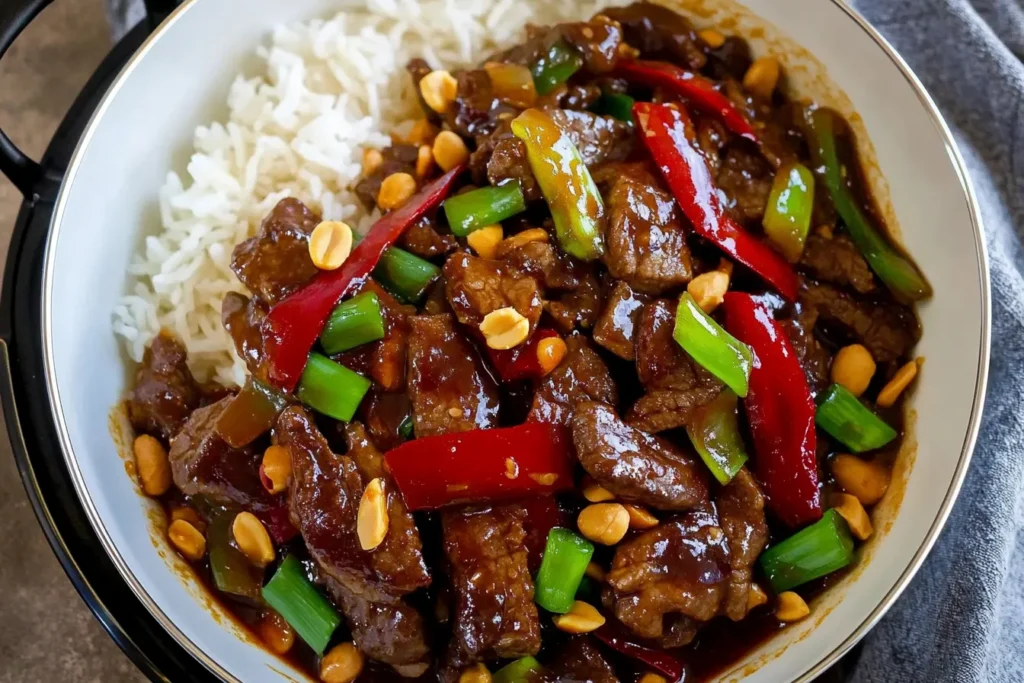
My version of Kung Pao Beef simplifies the traditional recipe, making it easy to cook at home with ingredients you can find at your local grocery store. It’s still packed with authentic flavor but skips some of the harder-to-find ingredients. Plus, you can easily adjust the spice level to make it perfect for your family, even picky eaters!
Ingredients You’ll Need
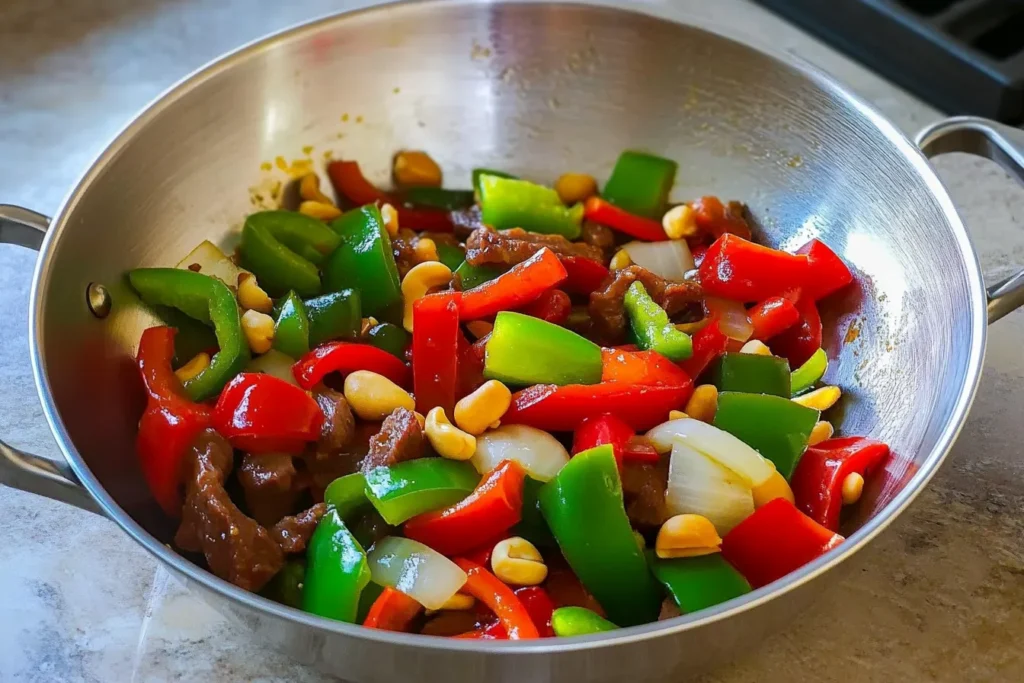
This Kung Pao Beef recipe is easier than you think! Here’s what you’ll need:
For the Beef
- 1 lb flank steak or sirloin steak, cut against the grain into thin bite-sized pieces (about 1/4 inch thick)
- Tip: Flank steak is traditional, but sirloin works well too. Cutting against the grain helps ensure tender beef.
For the Marinade
- 1 tablespoon soy sauce
- 1 tablespoon Shaoxing rice wine (or dry sherry)
- 1 teaspoon cornstarch
- 1/2 teaspoon ground white pepper
- Tip: This marinade helps tenderize the beef and adds a base layer of flavor.
For the Sauce
- 2 tablespoons soy sauce
- 2 tablespoons rice vinegar
- 1 tablespoon hoisin sauce
- 1 tablespoon sugar
- 1 teaspoon sesame oil
- 1/2 teaspoon ground Sichuan peppercorns (optional, for authentic flavor)
- Tip: This sauce balances sweet, sour, salty, and savory flavors for an authentic Kung Pao taste.
For the Stir-fry
- 2 tablespoons vegetable oil
- 1 red bell pepper, seeded and chopped
- 1 green bell pepper, seeded and chopped
- 1 small onion, chopped
- 3 cloves garlic, minced
- 1-inch piece of ginger, minced
- 1/2 cup roasted peanuts
- Tip: Feel free to add other vegetables like broccoli or carrots. Roasting the peanuts enhances their flavor and crunch.
Making the Kung Pao Beef
Now for the fun part – let’s get cooking!
Preparing the Beef
- Slice the beef against the grain into thin, bite-sized pieces. This is crucial for tender Kung Pao Beef.
- In a medium bowl, combine the sliced beef with the marinade ingredients (soy sauce, rice wine, cornstarch, and white pepper).
- Mix well and let the beef marinate for at least 15 minutes. This allows the marinade to penetrate the beef and tenderize it. You can marinate it for up to 30 minutes.
- Velveting the Beef (Optional but Recommended): Heat 1 tablespoon of oil in a wok or large skillet over medium-high heat. Quickly stir-fry the marinated beef until it’s lightly browned but not fully cooked. Remove the beef from the wok and set aside. This “velveting” step helps seal in the juices and ensures a more tender final product.
Making the Sauce
- In a small bowl, whisk together all the sauce ingredients: soy sauce, rice vinegar, hoisin sauce, sugar, sesame oil, and ground Sichuan peppercorns (if using).
- Make sure the sugar is fully dissolved. Set the sauce aside.
Stir-frying the Kung Pao Beef
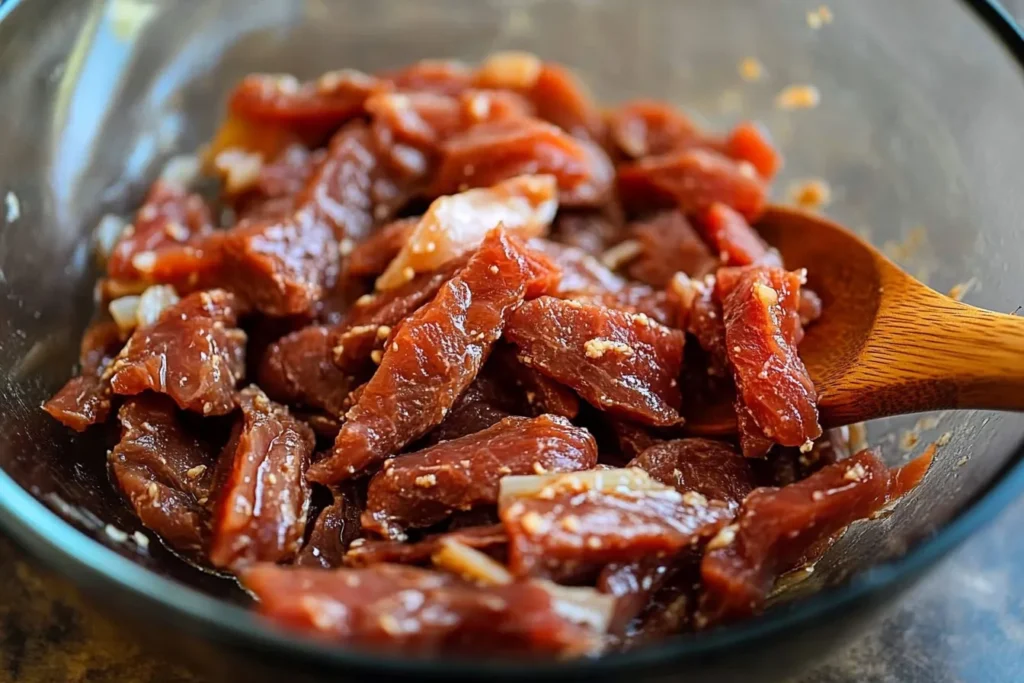
- Heat the remaining 1 tablespoon of oil in the wok or skillet over high heat.
- Add the chopped onion, bell peppers, garlic, and ginger to the wok. Stir-fry for 2-3 minutes until the vegetables are slightly softened but still crisp-tender.
- Return the partially cooked beef to the wok.
- Pour the prepared sauce over the beef and vegetables.
- Stir-fry everything together for another 2-3 minutes until the sauce thickens and coats the beef and vegetables evenly.
Adding the Peanuts and Final Touches
- Add the roasted peanuts to the wok and stir-fry for another minute to combine them with the beef and vegetables.
- Taste the Kung Pao Beef and adjust the seasoning if needed. You might want to add a pinch of salt or a splash more soy sauce.
- Serve immediately over rice or noodles.
Tips and Variations for Your Kung Pao Beef
This Kung Pao Beef recipe is a great starting point, but feel free to customize it to your liking!
Adjusting the Spice Level
The beauty of Kung Pao Beef is that you can easily adjust the spice level!
For a milder version, omit the Sichuan peppercorns and use fewer dried chilies.
If you like it extra spicy, add a pinch of red pepper flakes or a dash of chili garlic sauce along with the other sauce ingredients.
For a more authentic Sichuan flavor, add 1/4 – 1/2 teaspoon of ground Sichuan peppercorns. Start with less and add more to taste, as they have a unique tingling sensation.
You can also add a few dried red chilies to the wok along with the garlic and ginger for extra heat. Remove the chilies before serving if you prefer not to bite into them.
The health benefits of chillies, if you can tolerate them, are also notable.
Vegetable Variations
Feel free to get creative with the vegetables! While bell peppers and onions are traditional, you can add other vegetables like broccoli florets, sliced carrots, snow peas, or sliced mushrooms. Just add them to the wok along with the peppers and onions. If using denser vegetables like carrots or broccoli, you may need to stir-fry them for a bit longer to ensure they are cooked through. Consider using a delicious chicken fajita marinade to add depth to your choice of vegetables.
Protein Substitutions
Kung Pao isn’t just for beef lovers! You can easily adapt this recipe to use other proteins. Chicken breast, cut into bite-sized pieces, is a great substitute. For a vegetarian option, use firm or extra-firm tofu, pressed and cubed. Shrimp also works well – just add it to the wok towards the end of cooking as it cooks very quickly. Adjust cooking times as needed depending on the protein you choose. Consider the nutritional profile of the ingredients you choose to ensure a balanced meal.
FAQ
Here are answers to some commonly asked questions about Kung Pao Beef:
What is Kung Pao Beef?
Kung Pao Beef is a classic dish from the Sichuan province of China. It’s a stir-fry known for its bold and complex flavors – a combination of sweet, savory, and spicy, with a satisfying crunch from peanuts. The dish typically includes Sichuan peppercorns, which create a unique tingling sensation in the mouth.
What is the difference between Mongolian Beef and Kung Pao Beef?
While both are popular Chinese-American dishes, Mongolian Beef and Kung Pao Beef are quite different. Mongolian Beef features sliced beef in a sweet and savory brown sauce, often with onions. Kung Pao Beef, on the other hand, incorporates a wider range of flavors – sweet, sour, spicy, and savory – and includes peanuts and vegetables like bell peppers. If you’re looking for a simpler beef recipe, you might enjoy learning how to cook shredded beef, though the flavor profiles are distinct.
What is the difference between Kung Pao and General Tso?
General Tso’s chicken (or beef) is usually deep-fried, resulting in a crispy coating. The sauce is typically thicker, sweeter, and less complex than Kung Pao sauce. Kung Pao is traditionally stir-fried and features the distinctive numbing spice of Sichuan peppercorns, which are not typically found in General Tso’s.
What is Kung Pao vs Szechuan?
Szechuan (or Sichuan) refers to a style of cuisine from the Sichuan province of China, known for its bold flavors, especially the use of chili peppers and Sichuan peppercorns. Kung Pao is a specific dish within Szechuan cuisine. So, all Kung Pao dishes are Szechuan, but not all Szechuan dishes are Kung Pao.
Serving and Storing Your Kung Pao Beef
Here’s how to best enjoy and store your delicious Kung Pao Beef:
Serving Suggestions
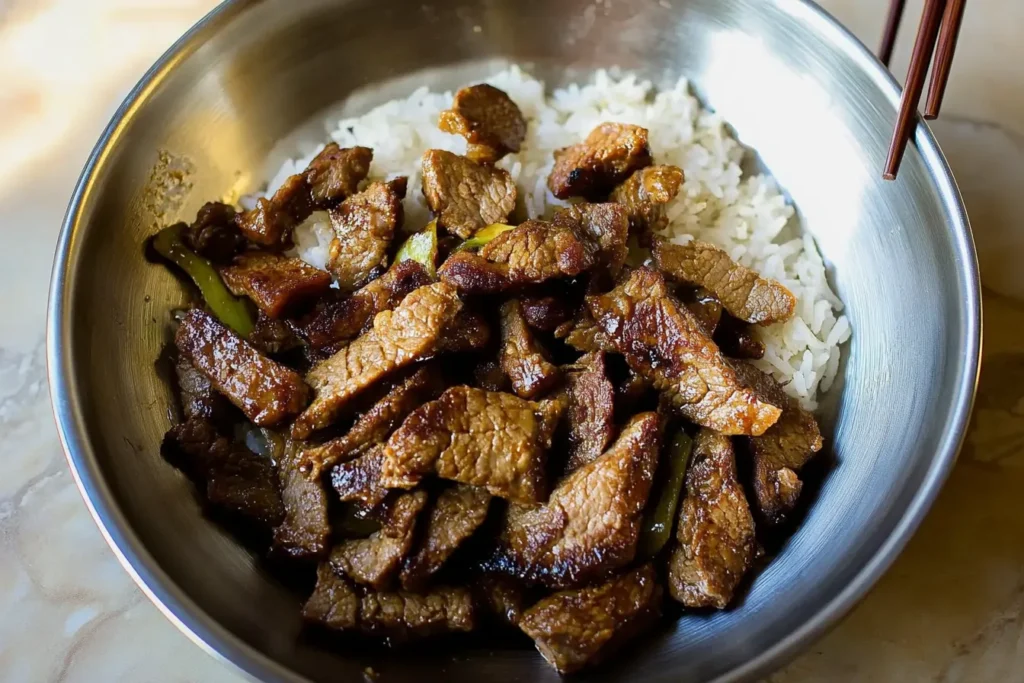
Kung Pao Beef is fantastic served hot over steamed white rice or noodles. The rice or noodles soak up the flavorful sauce perfectly. For a complete meal, add some steamed broccoli or a simple side salad. Garnish with chopped green onions or toasted sesame seeds for extra flavor and visual appeal. You can even add a sprinkle of chopped cilantro if you enjoy that fresh, herbaceous note. Consider pairing it with cream cheese wontons as a delicious appetizer.
Storing Leftovers
If you have any leftovers (which is rare!), store them in an airtight container in the refrigerator for up to 3 days. To reheat, you can microwave it in short bursts, stirring in between, or reheat it in a skillet over medium heat with a splash of water or broth to prevent it from drying out. Avoid over-reheating, as this can make the beef tough. For a different way to use leftover beef, you could explore beef recipes for inspiration.
Conclusion
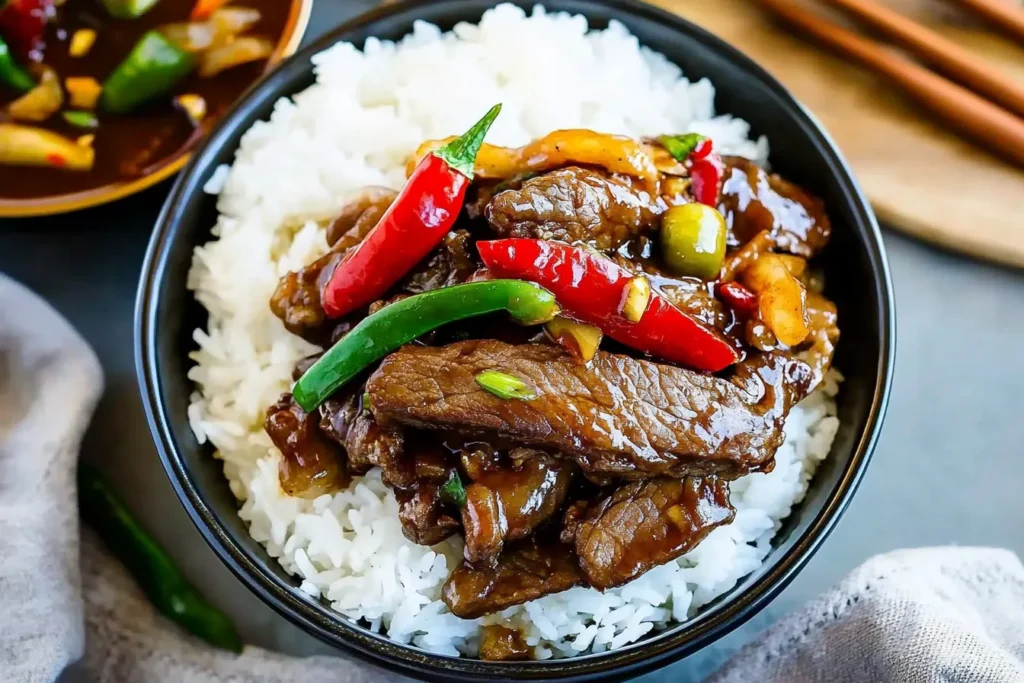
I hope you enjoy this easy and delicious Kung Pao Beef recipe! It’s a weeknight staple in our house, and I’m confident it will become a favorite in yours too. Give it a try and let me know what you think in the comments below. I always love hearing your feedback! I’m already thinking about sharing my family’s favorite sesame chicken recipe next – so stay tuned!
Print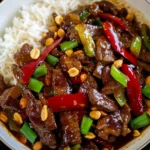
Kung Pao Beef
- Total Time: 15 minutes
- Yield: 4 servings 1x
Description
A classic Sichuan stir-fry with tender beef, crisp vegetables, peanuts, and a sweet, savory, and spicy sauce. Easy to make at home!
Ingredients
- 1 lb flank steak or sirloin steak
- 1 tablespoon soy sauce
- 1 tablespoon Shaoxing rice wine (or dry sherry)
- 1 teaspoon cornstarch
- 1/2 teaspoon ground white pepper
- 2 tablespoons soy sauce
- 2 tablespoons rice vinegar
- 1 tablespoon hoisin sauce
- 1 tablespoon sugar
- 1 teaspoon sesame oil
- 1/2 teaspoon ground Sichuan peppercorns (optional)
- 2 tablespoons vegetable oil
- 1 red bell pepper
- 1 green bell pepper
- 1 small onion
- 3 cloves garlic
- 1-inch piece of ginger
- 1/2 cup roasted peanuts
Instructions
1. Slice the beef against the grain into thin, bite-sized pieces.
2. In a medium bowl, combine the sliced beef with the marinade ingredients (soy sauce, rice wine, cornstarch, and white pepper).
3. Mix well and let the beef marinate for at least 15 minutes.
4. Heat 1 tablespoon of oil in a wok or large skillet over medium-high heat (optional velveting). Quickly stir-fry the marinated beef until lightly browned, then remove.
5. In a small bowl, whisk together the sauce ingredients: soy sauce, rice vinegar, hoisin sauce, sugar, sesame oil, and Sichuan peppercorns (if using).
6. Heat the remaining 1 tablespoon of oil in the wok or skillet over high heat.
7. Add the chopped onion, bell peppers, garlic, and ginger to the wok. Stir-fry for 2-3 minutes.
8. Return the partially cooked beef to the wok.
9. Pour the prepared sauce over the beef and vegetables.
10. Stir-fry everything together for another 2-3 minutes until the sauce thickens.
11. Add the roasted peanuts to the wok and stir-fry for another minute.
12. Taste and adjust the seasoning if needed.
13. Serve immediately over rice or noodles.
Notes
Adjust spice level to preference with chili flakes or chili garlic sauce. Substitute vegetables like broccoli, carrots, or mushrooms. Use chicken, tofu, or shrimp instead of beef.
- Prep Time: 15 minutes
- Method: Stir-Fry
- Cuisine: Sichuan, Chinese
Nutrition
- Serving Size: 1/4 of recipe
Keywords: Kung Pao Beef, beef stir-fry, Sichuan recipe, Chinese food, easy dinner, stir-fry recipe

